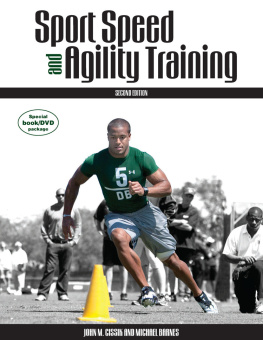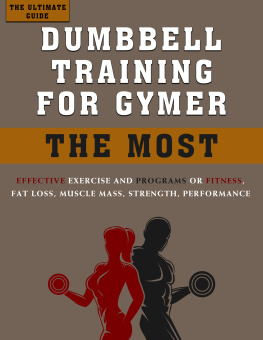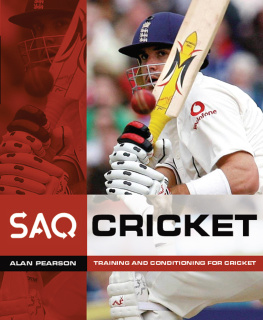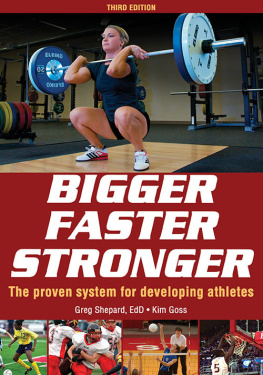Second Edition
Sport Speed and
Agility Training
John M. Cissik, MS, MBA, CSCS, NSCA-CPT
and
Michael Barnes, MEd., CSCS*D
2011 Coaches Choice. Second edition. All rights reserved. Printed in the United States.
No part of this book may be reproduced, stored in a retrieval system, or transmitted, in any form or by any means, electronic, mechanical, photocopying, recording, or otherwise, without the prior permission of Coaches Choice. Throughout this book, the masculine shall be deemed to include the feminine and vice versa.
ISBN: 978-1-60679-120-2
Library of Congress Control Number: 2010931253
Cover design: Brenden Murphy
Book layout: Bean Creek Studio
Diagrams: Kerry Hartjen
Text photos: John Cissik and Brenden Murphy
Fronte cover photo: Willie J. Allen, Jr./ St. Petersburg Times /ZUMA Press
Coaches Choice
P.O. Box 1828
Monterey, CA 93942
www.coacheschoice.com
We would like to acknowledge the following individuals for their contribution to Chapter 5 and their commitment to agility theory and practice:
- Jerry Attaway, Physical Development Coordinator of the San Francisco 49ers
- Steve Plisk, MS, CSCS, Sports Performance Director, Velocity Sports Performance
- Tom Billups, CSCS, Head Coach, USA Eagles Rugby
- Greg Halberg, MS, CSCS
Contents
Speed and agility are two of the most misunderstood components of sport. How to train for speed and agility is even more misunderstood. This book breaks down speed and agility into manageable components and analyzes those components to give coaches and athletes a strategic and methodical approach to training.
Many coaches consider speed and agility to be characteristics that athletes must be born with. It is true that everyone is limited by his own genetic potential, and it is in fact very difficult to develop speed and agility. However, once you break down speed and agility into their respective components, the situation becomes very manageable. With proper training, a slow athlete can become faster, a fast athlete can become even faster, and a good athlete can become great.
Examples of athletic performance include the ability to change direction easily, make an over-the-shoulder catch at full speed, create separation between you and your opponent, react to a changing environment, and start, stop, and reaccelerate. Many coaches do not have an integrated approach to training for athletic performance. Traditional methods consist of weight training for several weeks, followed by the incorporation of linear running. What is often missing from traditional training methods is agility and speed development. The traditional approach is a huge mistake, especially in the off-season, because it does not address specific neuromuscular responses, such as co-contractions of muscles (hamstrings and gluteus) with the displacement of body mass, possibly with a reactionary component (ball or opponent).
Athletes do need to train to become more effective at specific components of their game. For instance, training a football lineman would include weight training and cardiovascular training. It is also desirable for athletes to have strength and an efficient metabolic system. But according to the SAID principle (Specific Adaptations to Imposed Demands), if an athlete is concentrating on strength and metabolic training, he will improve only in those areas.
The best way to train for any sport is to practice the sport itself. If done properly, speed and agility training addresses sport-specific skills and the neuromuscular system in a manner that most closely resembles the sport itselfoften called functional training. The less the method of training resembles the sport, the less functional it is.
Speed and agility development also requires a different timeline than traditional training. The nervous system, motor abilities, and sport-specific movements will have little time to develop if they are not addressed outside of the pre-season. It takes weeks and sometimes months of training to see any significant results in speed and agility. It takes professional athletes years to refine sport-specific technique. Even then, fundamental errors occur with the most proficient athletes in game situations. Gone are the days of getting into shape during training camp. Todays professional athlete will take only two weeks off immediately following the season before beginning training for the next season.
This book has two basic parts. Part I covers the information that a coach or athlete needs to have to design and implement successful speed and agility programs. It presents scientific foundations that support speed and agility training. It also discusses, in detail, safety considerations, the warm-up, a dynamic flexibility program, speed training drills, and a theory of agility training.
Part II offers specific examples of speed and agility training programs for several sports (baseball, basketball, football, hockey, rugby, and soccer) that rely heavily on speed and agility for success. The authors developed these programs using what they believe to be the most methodical and practical approach to speed and agility development. The programs may or may not be appropriate for a particular program (collegiate, high school, club, or otherwise) because so many variables (including the competency of the instruction) need to be identified before implementing a speed and agility program. Therefore, the programs are based on a methodical and progressive model that can be adapted for use by any coach or athlete at any level.
This second edition also includes a companion DVD that explains each exercise and drill that is discussed in the text. As authors, we felt that a video would better define the specific movement techniques and patterns that you can use immediately with your athletes. The DVD also includes coaching cues and drill descriptions that you will find helpful when implementing sport speed and agility training.
Principles and Fundamentals
The first part of this book covers the information that a coach or athlete needs to have to design and implement successful speed and agility programs. The first chapter details safety considerations for speed and agility programs and discusses injury prevention. The next few chapters describe the various components in a speed and agility training program. Chapter 2 covers warming upwhy it is important and how to do it most effectively for speed and agility training. Chapter 3 describes speed trainingwhat factors affect speed, the components of speed, technique, and how to train each component. Chapter 4 outlines selected speed drills. Chapter 5 covers agility trainingthe science behind it (physiology, biomechanics, and motor learning), its constituents, training variables, and program design information. Chapter 6 describes the importance of the cooldown and how it can be implemented. Chapter 7 puts everything together and covers program design, including information on principles of exercise, analyzing the needs of the sport and the athlete, how the sports competition season affects program design, and how to incorporate speed and agility training into the bigger conditioning program.
Safety Considerations for Speed and Agility Training
Several broad-based issues directly pertain to safety for speed and agility training:
- Pre-exercise health screening
- Nutritional status
- Footwear
- How to choose a strength and conditioning coach
- Training surfaces
- Environmental conditions
An entire book could be devoted to a discussion of these issues. This chapter will provide only an overview, along with references to assist you in furthering your knowledge of these important safety considerations.
Next page






